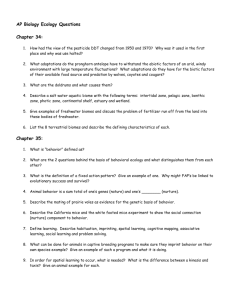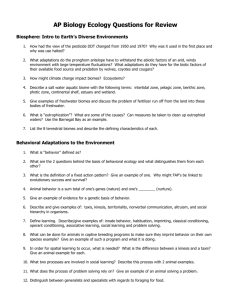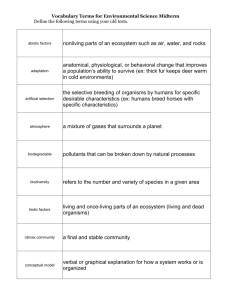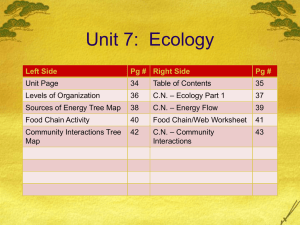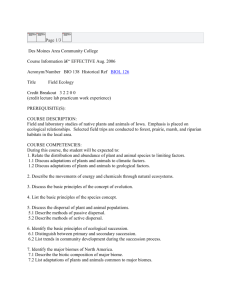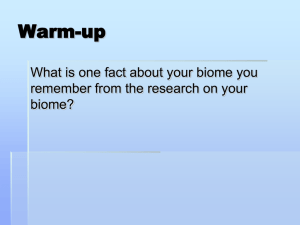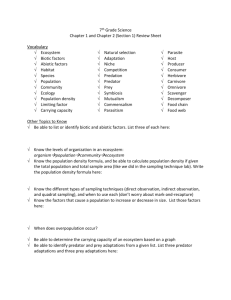Bio Chapter 21 Community Ecology
advertisement
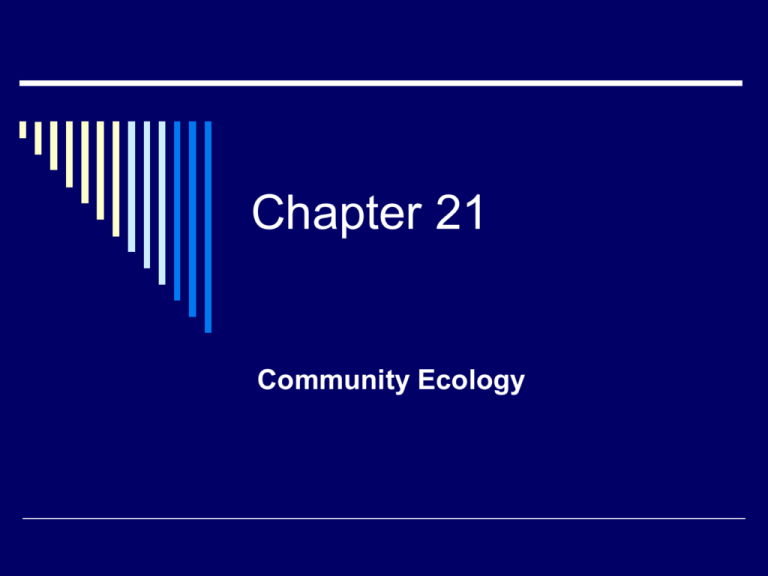
Chapter 21 Community Ecology 21.1 Species Interactions Communities contain populations that interact in many ways There are five major types of interactions (symbioses): predation, parasitism, competition, mutualism, and commensalism Predation A predator captures, kills, and consumes the prey Predation determines where and how a species lives Regulates population size Predators and Natural Selection Natural selection favors adaptations that improve the efficiency of predators (the better the hunter, the more food to survive) Examples: predator adaptations such as coat color, sharp teeth or claws, able to find prey (sense of smell, accurate vision) Prey and Natural Selection The survival of prey animals depend on their ability to avoid being eaten Examples: camouflage, poison, behavior, ability to hide, able to outrun predator Mimicry A harmless species resembles a poisonous one The mimic is protected since it is avoided Mullerian Mimicry When several dangerous/poisonous species have similar warning coloration Example: the black and yellow striped pattern on bees and wasps Batesian Mimicry When a harmless species mimics the warning coloration of a dangerous species Example: coral snakes and scarlet king snakes Plant-Herbivore Interactions Plants have evolved adaptations that protect them from being eaten by herbivores examples: thorns, spines, stinging hairs, tough leaves, chemical defenses Secondary Compounds Some chemicals in plants are poisonous, irritating, or bad-tasting Many plant chemicals are used for medicines There are many medicinal cures in rainforest plants, but they are being destroyed due to habitat destruction! Parasitism One individual is harmed while the other benefits The parasite feeds on the host Ectoparasites (external) Endoparasites (internal) Parasitism and Evolution Parasitism has caused an evolution of a variety of host defenses Natural selection favors adaptations that allow a parasite to exploit its host (very specialized bodies and lifestyles) Competition The use of the same limited resource by two or more species Competitive exclusion: one species can be eliminated from a community because of competition Competition in Paramecia G.F. Gause studied competition between two species of paramecia in the lab Character Displacement Competitors may evolve niche differences or anatomical differences that lessen the competition Example: Darwin’s finches Resource Partitioning When similar species coexist, each species uses only part of the available resources Example: warblers forage in different types of trees Mutualism A cooperative relationship in which both species benefit example: pollination (pollinators are attracted to a food source and transfer pollen to other flowers while feeding) Commensalism One species benefits while the other is not affected Example: cattle egrets feed on insects that fly out of the grass when the Cape buffalo is walking 21.2 Properties of Communities Species richness: the number of species a community contains Species diversity: relates the number of species to the relative abundance of each species Patterns of Species Richness Varies with latitude The closer to the equator, the more species (greatest in tropical rainforests) E.O. Wilson found more ant species in a single tree in Peru than there are in the entire British Isles Tropical Rainforests Climate is more stable than a temperate area Plants can photosynthesize year-round Tropical rainforests have the highest biodiversity on Earth The Species-Area Effect Larger areas usually contain more species than smaller areas (more habitats) Most often applied to islands Reducing the size of a habitat reduces the number of species Community Stability Stability refers to a community’s resistance to change and is directly related to species richness The more species, the more interactions and the better a habitat can withstand a disturbance 21.3 Succession A gradual process of change and replacement of the types of species in a community Ecosystems are constantly changing Primary Succession Occurs on a surface where no ecosystem existed before Example: rocks, volcanic islands, cliffs, sand dunes Primary Succession Happens very slowly Bare rock lichens moss grasses shrubs trees Example: Galapagos Islands Secondary Succession Most common type of succession Occurs on a surface where an ecosystem previously existed Occurs after an ecosystem is disturbed by humans or by storms, floods, earthquakes, or volcanoes Secondary Succession Pioneer species- the first organisms to colonize any newly available area Grasses and weeds shrubs shade intolerant trees shade tolerant trees climax community Example: eruption of Mt. St. Helens destroyed 44,460 acres of forest Old-field Succession When farmland is abandoned, it will start to turn back into a forest ecosystem Pioneer plants such as grasses and weeds will start to grow After about 100 years, the field will return to a climax community Old-field Succession


